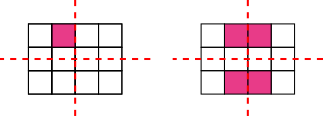Skip over navigation
The empty grid only has 2 lines of symmetry, as shown below, so when Mathias shades 4 squares, these will be the 2 lines of symmetry.

If Mathias shades one of the corner squares, then he must shade all of the corner squares, as shown below. That is one way to make a grid with 2 lines of symmetry by shading 4 squares.

If Mathias shades one of the other squares on the top or bottom row, then he must also shade the square next to it and the two squares vertically opposite, as shown below. That is another way to make a grid with 2 lines of symmetry by shading 4 squares.

If Mathias shades a square along the middle row, then he must also shade the square opposite it on the middle row. But then only 2 squares will be shaded. The only other squares he can shade are the other two squares on the middle row, because he has to shade another 3 squares if he shades any of the squares along the top or bottom rows. This is shown below.

So shading the 4 squares along the middle row is the only other way to make a grid with 2 lines of symmetry by shading 4 squares.
So there are 3 ways to do it. This is shown more fully on this grid, which shows the yellow pattern, the blue pattern and the pink pattern.

As we have seen, if Mathias shades one of the blue squares, he must return the grid with the 4 blue squares. If he shades one of the pink squares, he must return the grid with the 4 pink squares. Or if shades one of the yellow squares, he must return the grid with the 4 yellow squares.
So he must return one of these 3 grids.

Or search by topic
Number and algebra
Geometry and measure
Probability and statistics
Working mathematically
Advanced mathematics
For younger learners
Grid Symmetry
Age 11 to 14
ShortChallenge Level 





- Problem
- Solutions
The empty grid only has 2 lines of symmetry, as shown below, so when Mathias shades 4 squares, these will be the 2 lines of symmetry.

If Mathias shades one of the corner squares, then he must shade all of the corner squares, as shown below. That is one way to make a grid with 2 lines of symmetry by shading 4 squares.

If Mathias shades one of the other squares on the top or bottom row, then he must also shade the square next to it and the two squares vertically opposite, as shown below. That is another way to make a grid with 2 lines of symmetry by shading 4 squares.

If Mathias shades a square along the middle row, then he must also shade the square opposite it on the middle row. But then only 2 squares will be shaded. The only other squares he can shade are the other two squares on the middle row, because he has to shade another 3 squares if he shades any of the squares along the top or bottom rows. This is shown below.

So shading the 4 squares along the middle row is the only other way to make a grid with 2 lines of symmetry by shading 4 squares.
So there are 3 ways to do it. This is shown more fully on this grid, which shows the yellow pattern, the blue pattern and the pink pattern.

As we have seen, if Mathias shades one of the blue squares, he must return the grid with the 4 blue squares. If he shades one of the pink squares, he must return the grid with the 4 pink squares. Or if shades one of the yellow squares, he must return the grid with the 4 yellow squares.
So he must return one of these 3 grids.
You can find more short problems, arranged by curriculum topic, in our short problems collection.
You may also like
Hallway Borders
What are the possible dimensions of a rectangular hallway if the number of tiles around the perimeter is exactly half the total number of tiles?

